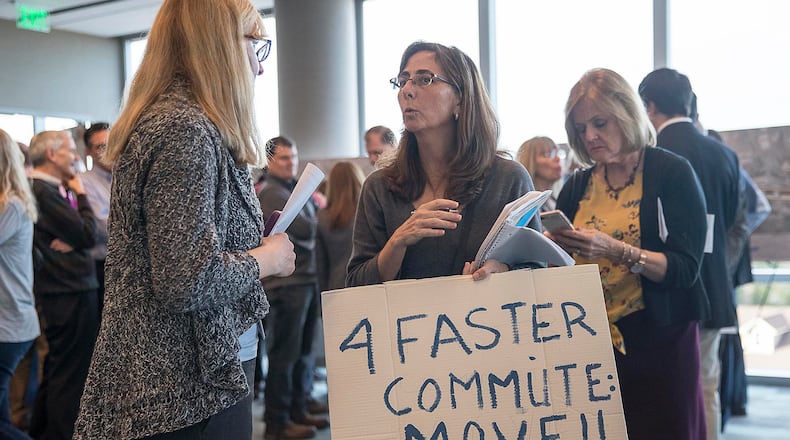Marta Dos Santos bought her dream house, spent tens of thousands of dollars to renovate it and moved in a year ago.
Then, last month, came the bad news: The Georgia Department of Transportation plans to buy her Sandy Springs home as it widens Ga. 400 in coming years. The house may be demolished to make way for express lanes that will whisk thousands of commuters into Atlanta each day.
“If we had known six months before, we wouldn’t have spent $20,000 on windows,” Dos Santos said Tuesday at one of several public meetings GDOT recently held to unveil details of its Ga. 400 plans.
She isn’t alone. Though its plans aren’t final, GDOT expects to buy about 40 homes as it widens a 16-mile stretch of the highway, most of them in Sandy Springs. Agency officials say they’re trying to balance the need for new lanes with sensitivity to the neighborhoods that will be affected.
“It’s a push-pull between a statewide need and ‘how is this going to affect my neighborhood?’ ” GDOT spokesman Scott Higley said. “We get that.”
It's a balancing act that may become more precarious in coming years as Georgia tries to squeeze more lanes into highly developed areas along Ga. 400 and I-285. Some residents worry their neighborhoods will be sacrificed as the state seeks to appease frustrated commuters.
“It’s what happens when you delay installing infrastructure for 30 years,” said Sandy Springs Mayor Rusty Paul, whose city sits at the junction of Ga. 400 and I-285. “It creates angst, anxiety and anger.”
Georgia lawmakers had the anxiety of commuters in mind in 2015 when they raised gas taxes to provide an extra $1 billion a year for road and bridge construction. Then-Gov. Nathan Deal later announced his plans for spending the money, which included 11 major projects statewide.
In metro Atlanta, those projects include new I-285 interchanges at I-20 east and west of Atlanta. They also include new express lanes along the top half of I-285 and along Ga. 400.
The new lanes are part of a planned 120-mile network of toll lanes designed to keep traffic moving for those willing to pay by the mile. The network includes existing lanes on I-85 northeast of Atlanta, I-75 south of the city, and I-75 and I-575 to the northwest.
The lanes have been a hit with many commuters. But that's little solace for residents worried that highway expansions will encroach on their communities.
“The lanes work. I get it,” said Paul Young of Sandy Springs. “But it only works until it comes through your neighborhood.”
Young was one of scores of residents from the Spalding Woods neighborhood who attended Tuesday’s open house in Sandy Springs. They studied detailed maps showing how GDOT’s plans for Ga. 400 could affect the area.
The agency plans to add two lanes in each direction on Ga. 400 from the North Springs MARTA station in Sandy Springs to McGinnis Ferry Road. From there, it will build a single lane in each direction to nearly a mile north of McFarland Parkway in Forsyth County.
The preliminary plan would require GDOT to buy about 40 homes.
Dos Santos and her husband, Marco Gomez, knew they were buying a home close to the highway. But they didn’t know about GDOT’s expansion plans. When they were summoned to a GDOT meeting last month, they thought they might lose part of their yard.
“Then they turned around and said, `We’re taking your house,’ ” Dos Santos said.
GDOT officials stressed that no final decisions have been made. The agency is seeking public comment on its plans. In coming months, it will refine those plans, then bring a final proposal back to the public.
But it’s proceeding with property acquisition in areas likely to be part of those final plans. Construction is set to begin in 2021, with the lanes opening in 2024.
Some residents say the agency has been too secretive about property acquisition. Mark Rosenthal of Sandy Springs complained about GDOT’s “cloak and dagger” approach.
Higley said the agency has gone beyond federal requirements for public notice and input, holding about 150 meetings with neighborhood groups, school administrators and others over the past two years. But until recently, its plans weren’t solid enough to discuss specific properties that might be acquired, he said.
Still, when something as personal as someone’s home is at stake, meetings don’t necessarily alleviate anxiety.
“The biggest concern is, we’re going to have 20 houses taken one street over from where we live,” Rosenthal said. “It brings 400 ever closer.”
Spalding Woods residents aren’t the only ones worried. GDOT’s next projects include express lanes along I-285 and on Ga. 400 from the interstate to the North Springs MARTA station. It’s a highly developed area, and more property acquisitions are likely.
Already, some Sandy Springs residents are worried about GDOT's plans to build an access point to the Ga. 400 express lanes at Mount Vernon Road. Sandy Springs has proposed an alternative access point on Crestline Parkway, which the city's mayor said would affect fewer residents.
But Paul said that would cost an extra $30 million, and GDOT has asked Sandy Springs to cover the additional cost. He said the city must decide “in a matter of weeks.”
Spokeswoman Natalie Dale said GDOT will consider all public input as it finalizes its plans for Ga. 400. Ultimately, it will be up to the U.S. Department of Transportation to decide whether to pay for the project.
But the federal agency has already given $184 million for the express lanes. And though it will consider community support before greenlighting construction, the affected community extends far beyond any one neighborhood. It includes the thousands of commuters who likely would benefit from the new lanes.
“The federal government can say it doesn’t have enough community support — but it’s not just one community,” Dale said.
Stay on top of what’s happening in Georgia government and politics at ajc.com/news/georgia-government/.
About the Author





